How to calculate the volume of the pipe and why we need this
Construction or repair processes are directly related to the need to replace old ones or to build entirely new communication pipelines. Taking up the drafting of the project for the upcoming work, you will certainly need to calculate the volume of the pipe.
We will talk about how to do this in this article.
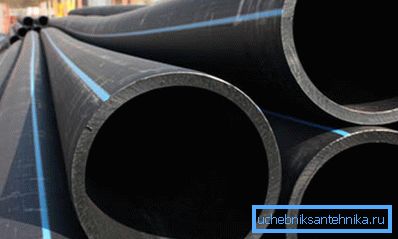
Why you need to know the volume
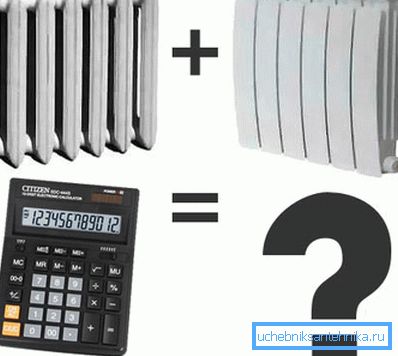
During the construction of a new building or during repair work, there are no details that are insignificant. But the calculation of such a parameter as volume is the most important for creating a communication highway (see also the article Calculating the diameter of a pipe for heating is an important stage in the design of the heating system).
In the process of designing a particular system, it will be necessary to calculate the volume of two types:
- External, also referred to as actual;
- Interior, also referred to as useful.
If you need to get a value equal to the amount of water in the pipe, then you need to calculate exactly the internal version.
Note! In order to obtain the necessary values you will have to use the most common school equations from the course of trigonometry. But in this case, the use of such formulas will border on practical knowledge of physics and mechanics.
If you calculate the volume of the pipe with some negligence and allow inaccuracies, then with a real water supply to the communication, the most common pressure in the network may be a high level of pressure, which will accelerate the wear of the created pipeline.
Perhaps, of course, the completely opposite situation, low pressure will cause the created system to not function as it should.
How to calculate
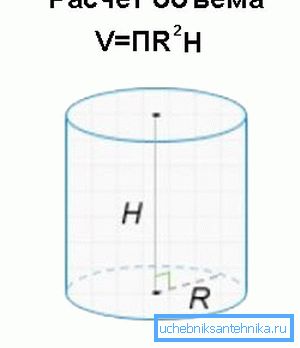
Instructions for the correct production of calculations in practice is implemented much easier than it might seem at first glance. But in order to avoid any difficulties, you must have at least minimal experience, but even inexperienced masters cope with these difficulties quite simply.
If you decide to install the pipeline yourself, then for calculations you should use the following algorithm of actions:
- First you need to know the value of the diameter of the selected material. It is at this stage that the pipe surfaces are already divided into internal and external, and besides these values, the other actions will be identical.
In order to calculate the diameter, it is possible and better to use measuring instruments, which will significantly simplify the calculations. In order to calculate the internal diameter of the pipe, it is sufficient to subtract two wall thicknesses from the external one.
Note! Often, in the invoices for the goods, the manufacturer or supplier specifies the external value, because the specificity of the work of such organizations makes it necessary to refer to this indicator in the first place.
- Next, it is necessary to calculate such an indicator as the radius, for which it is sufficient to simply divide by 2 the diameter calculated at the previous stage;
- Next, you need to calculate the cross-sectional area of the product.. For these calculations, use a simple trigonometric formula S =? * R2 (Section area = pi * squared radius);
Council Before starting the calculations, translate the parameter values into the required units, and the result will be measured in them, i.e. see go to see2, a m in m2.
- Now that all the necessary parameters for the calculation have been received, it remains only to make the appropriate calculation.. The trigonometric formula for pipe volume in m3 is as follows:
V = S * L, where S is the area calculated earlier, and L is the length of the trunk. The length in this case is measured on pipe sections with equal diameter.
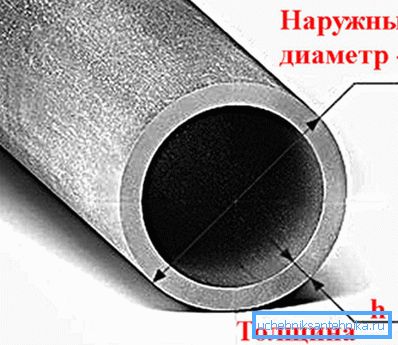
Note! If you need to get the value in liters, then you should convert the volume using the following ratio 1m3 = 1000l.
If there is a transition from one diameter to another in the pipe line, then the volumes of the sections before and after the transition are considered separately.
In order to calculate the volume of the transition, summarize the parameters of the cross section at the entrance and exit and calculate the volume after, dividing it by 2. Thus, you can get the average value.
Calculation of the amount of water
In order to understand how calculations are performed, consider an example. A pipe with a diameter of 30 cm was held in the room, which in the middle of its length begins to decrease in volume by half at a distance of 1 m. In order to make the calculation correctly, you will need to know the transition diameter.
Combining all the above calculations into a single formula, we get: V = 3.14 * ((0.3 / 2 + 0.15 / 2) / 2)2* 1 = 0.04 m3. In this case, the volume will be equal to the value obtained by multiplying the number pi by half of the sum of the radii of the transition, squared, and multiplied by the length of the transition.
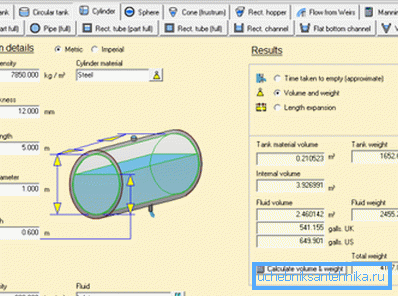
Council To simplify all calculations, you can use a pipe volume calculator, in which you simply enter the values of the internal diameter and length of the pipe.
Finally
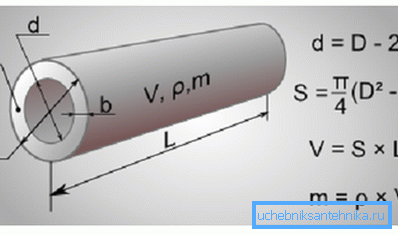
When you first take up the construction of the pipeline, you may not understand at all why it is necessary to calculate the volume, based on the opinion that people with relevant professional education should work with pressure.
But repairs can be associated with various situations and you may encounter the problem of excessive or insufficient pressure, and the cost of eliminating it can be quite high. Even if you take up the construction of the simplest fountain for children in the yard, where one of the pipe ends will be completely sealed.
In this case, if the volume is incorrectly calculated, the total will be different from what was expected.
The video in this article will demonstrate in practice how important it is to calculate the volume of a pipe through a diameter and how easy it is to make calculations.